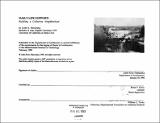| dc.contributor.advisor | Renee Y. Chow. | en_US |
| dc.contributor.author | Hamanaka, Leslie K. (Leslie Kinu) | en_US |
| dc.contributor.other | Massachusetts Institute of Technology. Dept. of Architecture. | en_US |
| dc.date.accessioned | 2011-11-01T19:36:37Z | |
| dc.date.available | 2011-11-01T19:36:37Z | |
| dc.date.copyright | 1990 | en_US |
| dc.date.issued | 1990 | en_US |
| dc.identifier.uri | http://hdl.handle.net/1721.1/66723 | |
| dc.description | Thesis (M. Arch.)--Massachusetts Institute of Technology, Dept. of Architecture, 1990. | en_US |
| dc.description | Includes bibliographical references (p. 69). | en_US |
| dc.description.abstract | Do the house forms and residential neighborhoods commonly found in the U.S. accommodate the present needs and lifestyles of the people who live in them? The single-family detached house and multi-family units like the triple-decker originated in an era quite unlike the one in which we now find ourselves. I intend to explore the possibility that we may not have to adapt to a dwelling sensibility that is restrictive and inappropriate for the late 20th and early 21st centuries. Perhaps the result will not look radically different than the models we already know but will only function in a subtly different manner, for very specific reasons of use and daily life. I will design a piece of a residential neighborhood in Newton Upper Falls, Massachusetts based on the premise that the physical, organizational, and functional aspects of housing design do affect and can contribute to the quality of people's lives. Some questions that I find valid for exploration in the context of housing are: 1) can a mix of uses animate a neighborhood by providing commonly needed services and by reducing the isolation of the home from everything else in life: work, shopping, child care, entertainment?; 2) have we been perpetuating outdated Victorian ideals about the separation of work and home based on roles related to gender? If so, couldn't housing design be more progressive in supporting the way women and men actually live today rather than the way one's great-grandparents lived?; | en_US |
| dc.description.abstract | (cont.) 3) if women still perform most of the household chores and child-rearing in the U.S. (whether married, single, or divorced), with the majority of American women also working full-time and getting paid two-thirds the salary of men, couldn't there exist a type of housing that considers the enormous demands on a person's time, energy, and resources necessary to accomplish all of this? I intend to research selected examples of feminist and experimental housing designs prior to starting my own. The Danish precedent of cohousing and Dolores Hayden's historical research and interpretive stance will establish my basic approach to the design project and its program. The design will be further informed by my own rethinking of domestic life and the architectural implications of it, recorded in "patterns" similar in intention to those of Alexander, et al. | en_US |
| dc.description.statementofresponsibility | by Leslie K. Hamanaka. | en_US |
| dc.format.extent | 69 p. | en_US |
| dc.language.iso | eng | en_US |
| dc.publisher | Massachusetts Institute of Technology | en_US |
| dc.rights | M.I.T. theses are protected by
copyright. They may be viewed from this source for any purpose, but
reproduction or distribution in any format is prohibited without written
permission. See provided URL for inquiries about permission. | en_US |
| dc.rights.uri | http://dspace.mit.edu/handle/1721.1/7582 | en_US |
| dc.subject | Architecture. | en_US |
| dc.title | Daily life support : building a collective neighborhood | en_US |
| dc.type | Thesis | en_US |
| dc.description.degree | M.Arch. | en_US |
| dc.contributor.department | Massachusetts Institute of Technology. Department of Architecture | |
| dc.identifier.oclc | 23166046 | en_US |
